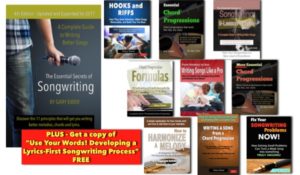Here’s something interesting that you may not have noticed about the songs you love: the part you love may only be a few beats long. The rest of the song has the main duty of building up and leading to that great moment.
Those first few beats are so enticing, so interesting, and so exciting, we sometimes don’t notice a lot about the rest of the song. That exciting bit within a song is what we would call the chorus hook, and if it’s a good one it can mean the difference between success and failure.
 Songwriters are very familiar with the chorus hook, but there are other kinds to experiment with, and you will want to discover the power of layering various kinds of hooks in the same song. “Hooks and Riffs: How They Grab Attention, Make Songs Memorable, and Build Your Fan Base“ shows you how it’s done.
Songwriters are very familiar with the chorus hook, but there are other kinds to experiment with, and you will want to discover the power of layering various kinds of hooks in the same song. “Hooks and Riffs: How They Grab Attention, Make Songs Memorable, and Build Your Fan Base“ shows you how it’s done.
Chorus hooks can get to a saturation point where we hear it too much, and that’s why:
- a verse can be an important way of giving the listener a break from the hook;
- a verse that’s too long can diminish the power of an otherwise great hook;
- a verse that doesn’t lead naturally to the hook can diminish the effect of that hook.
If your song just doesn’t seem to be working well for you — if it seems boring, or just “missing the point”, you’ll want to take each of those three points above and consider them carefully. If your song has a chorus hook and you still find the song is missing the mark, here’s how to quickly diagnose the problem.
Let’s assume that the hook you’ve written is good. You’ve played it by itself, and you like it. Is it possible to have a great hook and a lousy song? Absolutely! In fact, I consider it an important principle for songwriters to remember: a good hook won’t save a lousy song. You have to look deeper:
1. Look at how the verse is structured. Is it a good partner for your chorus? A verse on its own should still sound like a nice piece of music: don’t leave it completely up to your chorus to do all the heavy lifting. A high energy chorus needs a verse where you hear the pent-up energy in the verse that needs to get released.
A great example of a good verse-chorus partnership: “Don’t Kill My Vibe” (Sigrid Raabe, Martin Sjølie). A really nice verse comprised of a leap upward and then a mainly downward moving phrase. It’s not overly long, so it gets to the chorus quickly, and then we hear a great chorus hook (“oh-oh-oh-oh don’t kill my vibe…”) which moves steadily upward. People don’t consciously hear the contrast between downward and upward moving phrases, but structural elements are often perceived subconsciously:
2. Keep the verse from getting too long. A song where the energy seems to be dying before the chorus happens often means that the verse is just too long and wandering. Judge this carefully; there are times when a long verse, when the energy is carefully managed, can work.
But if, after listening to a recording of your song, you find that you’re losing interest before you get to the chorus, the best edit to make is one where the verse gets shortened. If you’ve done a double-verse kind of thing, kill the repeat of the verse and get right to the chorus.
In any event, the chorus of most pop songs will happen before the 1-minute mark, so use that as a basic design suggestion. Lady Gaga’s “The Cure” (Stefani Germanotta, Paul “DJ White Shadow” Blair, Lukas Nelson, Mark Nilan, Nick Monson) is a good example — a quiet verse, a pre-chorus that builds some energy, and then a chorus that starts at the 0’50” mark.
3. Identify the ways your verse naturally leads to the chorus — or doesn’t! There are many ways to do this:
- Switch from mainly minor chords in the verse to mainly major chords in the chorus.
- Have the verse melody gradually move upward to meet the start of the chorus.
- Have the verse lyric pose questions, set up situations, or describe circumstances in such a way that the chorus can express an appropriate emotion.
- Build your instrumentation and production, but let the chorus have a natural kind of “pop” that distinguishes it from the verse. Transparent to full is the key feature.
 Written by Gary Ewer. Follow Gary on Twitter.
Written by Gary Ewer. Follow Gary on Twitter.
 “The Essential Secrets of Songwriting” eBook bundle comes with a free copy of “Use Your Words! Developing a Lyrics-First Songwriting Process.” Learn how to make the writing of a good lyric the starting point for your own songwriting method.
“The Essential Secrets of Songwriting” eBook bundle comes with a free copy of “Use Your Words! Developing a Lyrics-First Songwriting Process.” Learn how to make the writing of a good lyric the starting point for your own songwriting method.











Pingback: Using Melodic Range to Create Musical Energy | The Essential Secrets of Songwriting